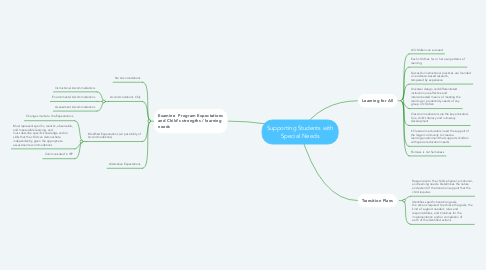Supporting Students with Special Needs
by Steven Gillespie

1. Examine Program Expectations and Child's strengths / learning needs
1.1. No Accomodations
1.2. Accommodations Only
1.2.1. Instructional Accommodations
1.2.2. Environmental Accommodations
1.2.3. Assessment Accommodations
1.3. Modified Expectations (w/ possibility of Accommodations)
1.3.1. Changes made to the Expectations
1.3.2. Must represent specific, realistic, observable, and measurable learning, and must describe specific knowledge and/or skills that the child can demonstrate independently, given the appropriate assessment accommodations
1.3.3. Communicated in IEP
1.4. Alternative Expectations
2. Learning for All
2.1. All children can succeed
2.2. Each child has his or her own patterns of learning
2.3. Successful instructional practices are founded on evidence-based research, tempered by experience
2.4. Universal design and differentiated instruction are effective and interconnected means of meeting the learning or productivity needs of any group of children
2.5. Classroom educators are the key educators for a child’s literacy and numeracy development
2.6. • Classroom educators need the support of the larger community to create a learning environment that supports children with special education needs
2.7. Fairness is not Sameness
3. Transition Plans
3.1. Responsive to the child’s physical, emotional, and learning needs. Determines the nature and extent of the transition support that the child requires
3.2. Identifies specific transition goals, the actions required to achieve the goals, the kind of support needed, roles and responsibilities, and timelines for the implementation and/or completion of each of the identified actions



